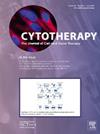cGMP production of hiPSC-Glial Enriched Progenitors, a cell-based therapy to treat white matter stroke and vascular dementia.
IF 3.7
3区 医学
Q2 BIOTECHNOLOGY & APPLIED MICROBIOLOGY
引用次数: 0
Abstract
Background and Aims
Stroke is the leading cause of adult disability and the second leading cause of dementia. White matter stroke (WMS) constitutes up to 30% of all stroke subtypes, and it is a distinct process from “large artery stroke”. WMS starts as small infarcts in deep penetrating blood vessels in the brain but progresses, accumulates, and expands from preexisting lesions into adjacent white matter to produce hemiparesis with incomplete recovery, gait abnormalities, cognitive decline, and difficulties in executive functioning that present as vascular dementia. Unlike “large artery stroke”, WMS does not damage neuronal cell bodies, but damages axonal tracts and glial cells. Therefore, a cell-based therapy that can replace lost glia and induce structural repair in WMS/VaD is of great promise.
Methodology
In this study, we have developed a unique allogenic human induced pluripotent stem cell (hiPSC) derived Glial Enriched Progenitor (GEP) cell therapy product for the treatment of WMS and VaD.
Results
We have demonstrated that hiPSC-GEPs transplanted into the brain after WMS/VaD promoted motor and cognitive recovery through 3 mechanisms of action: axonal growth, astrocytic modulation, and oligodendrocyte differentiation and remyelination. To date, we have also qualified the entire manufacturing process for the intended therapeutic candidate, hiPSC-GEPs, through safety, identity, purity, activity, and stability qualification assays. To demonstrate the scale-up manufacturing capabilities of the potential therapeutic product, we have developed a new cGMP manufacturing protocol and produced well above the necessary number of cells for phases 1 and 2 of a future clinical application.
Conclusion
This preliminary work could pave the way for a faster route to Pre-IND, FDA approval, and a future clinical application.
hipsc -胶质富集祖细胞的cGMP生产,一种基于细胞的治疗白质卒中和血管性痴呆的方法。
背景和目的中风是导致成人残疾的主要原因,也是导致痴呆的第二大原因。白质卒中(WMS)占所有卒中亚型的30%,与“大动脉卒中”不同。WMS开始于大脑深部穿透性血管的小梗死,但发展、积累并从先前存在的病变扩展到邻近的白质,导致偏瘫,不完全恢复,步态异常,认知能力下降和执行功能困难,表现为血管性痴呆。与“大动脉卒中”不同,WMS不损害神经元细胞体,但损害轴突束和胶质细胞。因此,在WMS/VaD中,以细胞为基础的替代失去的胶质细胞并诱导结构修复的治疗是很有希望的。在这项研究中,我们开发了一种独特的同种异体人诱导多能干细胞(hiPSC)衍生的胶质富集祖细胞(GEP)细胞治疗产品,用于治疗WMS和VaD。结果研究表明,在WMS/VaD后,hiPSC-GEPs通过轴突生长、星形细胞调节、少突胶质细胞分化和髓鞘再生3种机制促进了运动和认知功能的恢复。迄今为止,我们还通过安全性、鉴定、纯度、活性和稳定性鉴定分析,对预期治疗候选物hiPSC-GEPs的整个制造过程进行了认证。为了证明潜在治疗产品的规模化生产能力,我们开发了一种新的cGMP生产方案,并生产了远远超过未来临床应用1期和2期所需数量的细胞。结论该初步工作为该药物更快地进入Pre-IND、FDA批准和未来临床应用铺平了道路。
本文章由计算机程序翻译,如有差异,请以英文原文为准。
求助全文
约1分钟内获得全文
求助全文
来源期刊

Cytotherapy
医学-生物工程与应用微生物
CiteScore
6.30
自引率
4.40%
发文量
683
审稿时长
49 days
期刊介绍:
The journal brings readers the latest developments in the fast moving field of cellular therapy in man. This includes cell therapy for cancer, immune disorders, inherited diseases, tissue repair and regenerative medicine. The journal covers the science, translational development and treatment with variety of cell types including hematopoietic stem cells, immune cells (dendritic cells, NK, cells, T cells, antigen presenting cells) mesenchymal stromal cells, adipose cells, nerve, muscle, vascular and endothelial cells, and induced pluripotential stem cells. We also welcome manuscripts on subcellular derivatives such as exosomes. A specific focus is on translational research that brings cell therapy to the clinic. Cytotherapy publishes original papers, reviews, position papers editorials, commentaries and letters to the editor. We welcome "Protocols in Cytotherapy" bringing standard operating procedure for production specific cell types for clinical use within the reach of the readership.
 求助内容:
求助内容: 应助结果提醒方式:
应助结果提醒方式:


